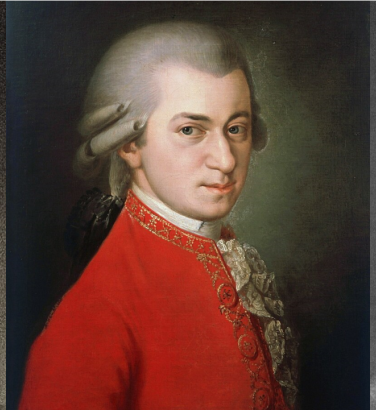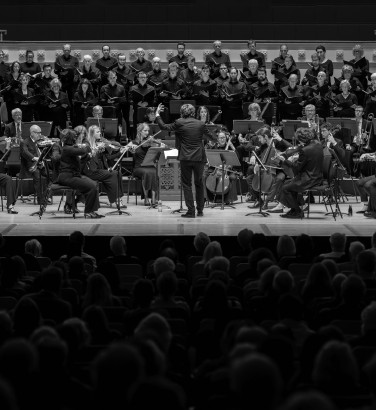
Heavenly realms
6 May 2024
News Story
Detail from The Adoration of the Kings (Girolamo da Treviso the Younger, 1524-25)
While spectacular depictions of the Christian understanding of heaven abound in all the creative arts, the sonic possibilities of music arguably allow for the widest variety of these. Add voices, and the words they sing introduce a further dimension with the setting of often evocative text. Consider, for example, how the dark mood of Mahler’s Symphony No 2 (Resurrection) undergoes a transformation with the alto entry – no voice having been heard prior to this – in the fourth movement, and again when the choir first enters in the finale. The former expresses a desire for some sort of meaning in life, and the latter develops this into the hope of lasting renewal.
Beethoven’s Symphony No 9 (Choral), one of the clear models for Mahler’s Resurrection, also fervently looks for something beyond mortal realms. This is especially effective in the composer’s setting of the words ‘über'm Sternenzelt / Muß ein lieber Vater wohnen’: ‘a loving father dwells amid the canopy of stars’, the choir sings, to an accompaniment of oscillating harmonies by the higher instruments of the orchestra, a shimmering representation of the divine that is at once bright and unknowable.
When it comes to depicting the heavens, there is no doubt works for chorus and orchestra benefit considerably from what the latter can contribute. They add considerably to the joyous atmosphere of Haydn’s Creation, in which the chorus is explicitly referred to as the heavenly host by the soloists, who are themselves identified as the archangels Gabriel, Uriel and Raphael. A more delicate approach is taken by Mendelssohn for ‘For he shall give His angels’ (a quiet moment amid the drama of Elijah), with rising string figurations representing the angels' support "lest thou dash thy foot against a stone", all underpinned by a warm bed of woodwind chords.
Like the Mystic Chorus which joins the final movement of Elgar’s The Apostles, or the In paradisum which closes both Fauré’s and Duruflé’s settings of the Requiem, these are largely depictions of Heaven as still images. This would also be true of ‘Glory to God’, in the Nativity section of Handel’s Messiah, if it weren't for the touch of dramatic flair the composer employs at the very end of this chorus. The main body of the movement, showing the angels announcing Christ’s birth to the shepherds, is as celebratory as you’d expect, but Handel goes on to convey their subsequent return into the heavens, with only the upper strings left to play on as they fly up and eventually disappear from sight.
This same text opens the Sanctus, a set part of the Mass identified as the angels’ hymn, and composers vary wildly in their response to it. Most opt for a grandiose depiction of the divine majesty - partly to contrast with the Benedictus which follows immediately afterwards in the liturgy, typically a much gentler affair - and among the very grandest is from Bach’s Mass in B minor. Others adopt a subtler approach, but one of the more unusual settings comes in Vierne’s Messe solennelle, which takes its time to build to a climax from an opening that is all hushed anticipation.
Yet is that Highest farre beyond all telling,
Fairer than all the rest which there appeare
Though all their beauties joynd together were.
How then can mortal tongue hope to expresse
The image of such endlesse perfectnesse?
It is in music for performance in church services that the greatest variety in depictions of the heavenly realms can be found, specifically in anthems (where any variety of text can be set). Some of these make spectacular use of the organ – Finzi creates some wonderfully pungent harmonies to reflect the angels’ depiction as ‘sparkling courtiers […] in flakes of Glory’ in God is gone up, but even these pale next to the extraordinary soundscape Weir establishes in Ascending into Heaven – but those for unaccompanied voices are arguably even more evocative. The poet Edmund Spenser may consider the beauty of celestial beings to be beyond human expression, but for choral singers the world over, Harris’ Faire is the Heaven (a setting of this poetry) comes extraordinarily close, and Bairstow’s depiction of these same denizens in Let all mortal flesh keep silence is not far behind.
A sense of mysticism creeps into depictions of Heaven as the dwelling-place of departed souls: Parry’s Songs of Farewell refers to this in its opening movement (My soul, there is a country) but even more so in the later At the round earth’s imagined corners. That said, it is perhaps when moving away from a purely Christian understanding of Heaven that the sheer vastness of the heavens really hits home: Ešenvalds’ Stars uses water-tuned glasses to create an otherworldly backdrop to Sara Teasdale’s poetry, to entrancing effect.
Related Stories
![Three men, the first two in 18th century formal dress (one in black and white, one in a red coat), the last in an old photo, smoking]()
What is a sinfonia concertante?
17 March 2025
We delve into the history of a hybrid genre ...![]()
The SCO Chorus on music for Lent
10 March 2025
With Easter just around the corner, we delve into perhaps the richest (and often darkest) choral repertoire of all ...![]()
The bassoon concerto
3 March 2025
For the last article in our concerto series (for now), we turn to an instrument too often dismissed as the orchestra's resident joker.


